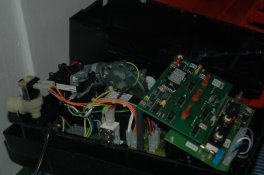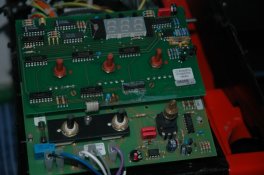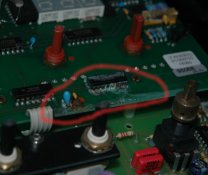So, the chip and capacitors are ok then?
What should I look for?
The rest of the circuit looks fine (for a layman).
If the relay turns on/off as you adjust the target temperature setting, the chances are high that the circuit is working (you would expect the point at which the relay flips to be around the current ambient temperature - i.e. if the water is currently at 21 celcius, you'd expect that the relay would flip as you move the target temperature setting past 21C.)
For what it's worth, the chip you identified - a 7485 - is a 4-bit comparator; this is, it compares two digital numbers and outputs an indication of which is higher (or if they are equal.) It very likely is a part of the thermostat circuit, therefore (the output of the comparator would be what turns the relay on/off to turn the heater on when the sensed temperature is less than the set temperature.) If the relay isn't behaving as described above, then this chip is therefore implicated; it sounds more likely though that it's all working as intended from what you describe.
In which case, if the relay is operating correctly, that more or less leaves the heating element, which is sad - if the element is buggered you're going to need Jobo to provide the replacement.
As far as I know (I have a CPE rather than a CPP, but I assume the element is the same) the element is of the nichrome-heating-wire-inside-a-ceramic-pipe variety. The two main failure modes are the heating element breaking, or the ceramic cracking.
Presumably, the ceramic hasn't cracked. If it had, the earth-leakage circuit breaker (which you
do use, I hope) would trip as soon as the heating element turns on. A cracked element means the water in the bath is connected to the mains when the heater turns on (if the appliance wasn't connected to earth for some reason, this would make it a real hazard) - an RCD/GFCI breaker will detect this as earth leakage and trip.
If the wire has just broken, there's not a lot you can do other than replace the element though :-(.
There is some good news though:
A fault with the heating element is easy to diagnose for anyone with a multimeter. With the element disconnected, use the resistance checker to check continuity through the element (there should be a high resistance, but not open circuit.)
To check for a crack in the ceramic, fill the bath with water and then check resistance from the heater element to the outer layer (which is normally earthed.) It should be open circuit if the ceramic isn't cracked.
There may be some other components in the heater element circuit other than the relay and the element itself; there may be a separate fuse for the heating element, there may also be a thermal fuse which will blow if the thing has ever overheated (e.g. by being operated with no water in the bath,) it could even just be a loose wire. So don't panic yet

.













 .)
.)
